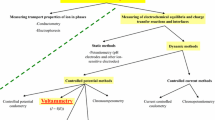Summary
-
(1)
The hypothesis that stimulants solate and depressants gelate protoplasm is given further support from research on slime moulds.
-
(2)
The xanthine derivatives, caffeine, theobromine and theophylline, cause a remarkable liquefaction of protoplasm.
-
(3)
The opiates, morphine and heroin, have the same solating effect on protoplasm as do the xanthines.
-
(4)
Sodium and potassium salts, the nitrates and nitrites more than the chlorides, lower the viscosity of protoplasm greatly, and both ions are known to produce stimulation.
-
(5)
Benzedrine, noted for its highly stimulating effect on man, liquefies the protoplasm of slime moulds.
-
(6)
The change observed when stimulants, or depressants such as anaesthetic agents, are added to protoplasm, is one in viscosity; but it involves more than this. The structural continuity which characterizes living matter is disturbed: in anaesthesia the bonds, holding the structural units together, are tightened; in stimulation the structural ties are loosened. Where the bonds are completely and irreversibly severed, as in high concentrations of stimulating agents, the outpouring of the protoplasm results in death.
Similar content being viewed by others
Literatur
Astbury, W. T., in Essays on Growth and Form, herausgeg. von E. Clark und P. B. Medawar, S. 309, Oxford (1945).
Bancroft, W. D., und Richter, G. H., The Chemistry of Anaesthesia, J. Phys. Chem.,35, 215–268 (1931).
Bernard, C., Leçons sur les anésthesiques et sur l'asphyxie. Baillère et fils, Paris (1875).
Bungenberg de Jong, H. G., La coacervation, les coacervats, et leur importance en biologie, Vol. 1 und 2, Paris (1936).
Dujardin, Ann. Sci. Nat., 2. Serie, Zool.4, 343 (1835).
Frey-Wyssling, A., Submicroscopic Morphology of Protoplasm and its Derivatives, New York (1948).
Goodman L. und Gilman, A., The Pharmacological Basis of Therapeutics, S. 191–192, New York (1941).
Heilbrunn, L. V., An Outline of General Physiology, S. 459, Philadelphia (1943).
Meyerhof, Biochem. Zeitschr.,33, 291 (1911).
Pauling, L., The Nature of the Chemical Bond, Ithaca, New York (1940).
Schwarz, Pflügers Archiv,117, 161 (1907).
Seifriz, W., The Structure of Protoplasm, Ames, Iowa (1942).
—, Anesthesiology,2, 300 (1941).
- Anesthesiology, im Druck.
—, and Pollack, H. L., A Colloidal Interpretation of Biological Stimulation and Depression, J. Coll. Sci.,4, 19 (1949).
- et Pollack, H. L., Toxicité et structure moléculaire des xanthines. Archives des Sciences. 1949.
Treloar, L. R. G., Repts. Progress Phys.,9, 113 (1943).
Weber, F., Ber. deutsch. bot. Ges.,40, 212 (1922), ibid., 254.
Author information
Authors and Affiliations
Additional information
Wir sprechen unseren Dank für finanzielle Unterstützung dem Sloan-Kettering-Institut und der Krebs-Kommission der University of Pennsylvania aus.
Rights and permissions
About this article
Cite this article
Seifriz, W., Pollack, H.L. Eine Theorie über den Mechanismus der Erregung. Protoplasma 39, 55–61 (1949). https://doi.org/10.1007/BF01249015
Received:
Issue Date:
DOI: https://doi.org/10.1007/BF01249015




